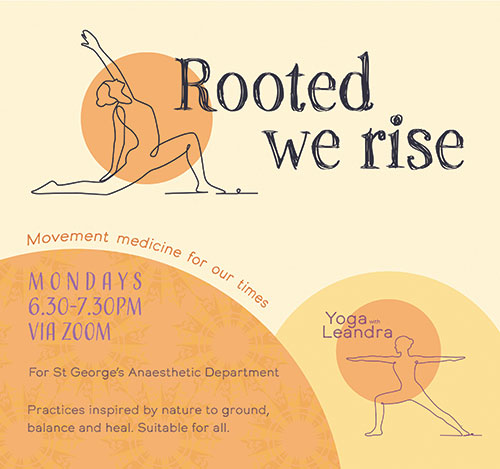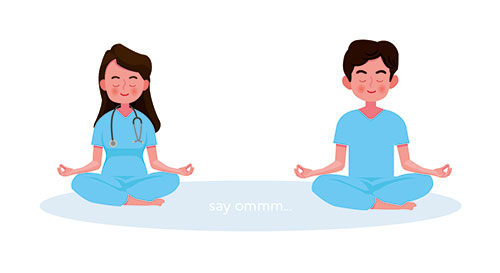Yoga for Anaesthetists
Introduction – Robert Self
‘Yoga in centuries past was a mystic wonderland
in which the practices differed from our own
in ways that ranged from the mundane to the
almost unimaginable.’ William J Broad [1].
Until about two years ago, I viewed yoga as an
obscure ‘new age’ cult, and would have laughed
at the suggestion of going to a yoga class. It
didn’t seem to be something for a man in his
late forties, but rather something for athletic
celebrities pictured in magazines. My first yoga
class happened entirely by accident while on a
walking holiday in the Lake District. One of the
walkers also happened to be a yoga teacher,
and led a class after a long walk. Perhaps it was
the scenery and amazing weather, but I came
away from the class with a remarkable feeling of
wellbeing that was difficult to explain. I decided
to give yoga a try, and have been a regular ever
since. To date, I have always left a yoga class
feeling better than when I arrived.
Throughout COVID-19, I have found a daily yoga
practice (even just five minutes) to be a calm
place during stormy times. Although missing
face to face classes, YouTube and live Zoom
classes have been surprisingly good. During
lockdown, many of us discovered and enjoyed
free yoga resources such as ‘Yoga with Adriene’
[2] – led by Adriene Mishler and her dog, Benji.
I believe that some of the benefits of yoga are
transferable from the mat into the operating
theatre, in particular the breathing practices.
In the rest of this article, I have asked my
co-authors to share some pointers for getting
started with yoga, and how this may fit into the
busy lives of anaesthetists. On a personal note,
I would like to thank the amazing teachers at
Triyoga, with special mention to Serena Davis
and teachers running the NHS online classes
during lockdown. Finally, a big thank you to
the yoga teacher and walker who started my
accidental introduction to yoga.
An individual and departmental
perspective – Katherine Horner
“Yoga allows you to find an inner peace that is not ruffled and
riled by the endless stresses and struggles of life.” BKS Iyengar
I have practiced yoga regularly for the past five years. I’ve stuck
with it because I think it’s one of the most holistic forms of
exercise there is. Yoga relaxes the mind whilst simultaneously
improving strength, flexibility, balance and aerobic capacity.
Yoga works on every muscle of the body from the flexor
digitorum brevis to frontalis - all without any expensive
equipment, just comfortable clothing and a mat.
Simply put, when I attend yoga classes regularly, I feel better. I
feel freedom in my daily movements, have better posture, better
sleep, a more relaxed and even approach to life and sudden
awkward twists and turns at work don’t pull any muscles (we’ve
all had to intubate a patient on the floor, or turn awkwardly to
reach the anaesthetic machine in a less than ideal position).
Yoga is often described as a ‘moving meditation’. Both
movement and meditation now have a strong evidence base
for improving health. Yoga also improves balance. Our ability to
balance declines significantly as we age, and a fall will land a lot
of us in hospital or be our pre-terminal event when we’re older.
There is always a strong emphasis on breathing during a yoga
class. This is because smooth, regular, deep breathing stimulates
the vagal nerve and parasympathetic nervous system. One of
the aims in yoga is to keep your breath smooth and your face
relaxed, whilst the body is challenged with postures of varying
complexity. Of course, the ultimate aim is for yoga to translate
unconsciously into daily life, training you to remain calm, with
smooth and even breathing, despite the stresses, strains and
indeed crises around you.
I would say that yoga is attractive to ‘over-achieving’ medics
because it is easy to track progress. Postures that were once
impossible become easy as flexibility and strength improve.
Furthermore, there is always another challenge, even for the
most experienced practitioner. Again, the real achievement is
when yoga practice translates into daily life. An elderly woman
once told me how yoga had enabled her to put on her socks for
the first time in a decade.
Yoga is an incredibly useful tool for promoting and maintaining
wellbeing amongst anaesthetists and theatre staff. As a trainee at
Northwick Park Hospital, I arranged for the day surgery recovery
unit, which was not used overnight, to become a temporary yoga
studio once a week from 7.00 - 7.45 A.M. with a
visiting teacher. Although most trusts offer exercise
classes, they often don’t fit well with the operating theatre
schedule. It was useful to have a class that allowed us to practice
within the theatre complex, and then go straight off to assess our
patients for the day.
More recently, during the COVID-19 pandemic, I set up regular
yoga classes for our department via Zoom, which worked really
well (Figure 1). The benefit of a Zoom yoga class is that it gives
the sense of practising together, whilst allowing privacy and
social distancing. Colleagues often say “hello” and “goodbye” at
the start and end of each class, but turn their cameras off whilst
practising, allowing them to retain their dignity! Additionally,
the live Zoom class was recorded and could be replayed during
the week, or accessed by those who missed the class due to
an overrunning list. A word of caution: I would say that a mixed
ability yoga class via Zoom requires a highly experienced
teacher to keep everyone safe from injury. Our teacher, Leandra
Ashton, targeted the classes specifically to the needs of
anaesthetists, and has so far focused on shoulders, neck, upper
back, arms and wrists, alongside relaxation (Yoga with Leandra;
on Facebook or
[email protected]).

As I finish writing this article, the words of a very famous yoga
teacher BKS Iyengar from Pune, India, come to me “Words
cannot convey the value of yoga – it has to be experienced” and
so all there is left to say is, why not give yoga a try yourself?

View from a yoga teacher – Cathy Bailey
I had the idea for Office Om over ten years ago. I was in a senior
role in the Civil Service. Keen to exceed targets, there were
never enough hours in the day. I drove home each day feeling
anxious and grumpy, with headaches and pain in my neck,
shoulders and wrists. My employer gave me new equipment,
but it didn’t make a difference. Meanwhile, I was feeling great
in a yoga class for 90 minutes each week. It was suggested I
stretched more at my desk and I discovered desk yoga – the
idea for Office Om was born.
I had been training as a counsellor in the background, and
when I subsequently trained as a yoga teacher, I was struck by
the overlap between the two. There is so much in modern day
psychology and wellbeing theory that can be seen in yoga texts
from thousands of years ago.
There are so many misconceptions that are a huge block to
people trying yoga. There is a belief, strengthened by all the
social media-fuelled images of people doing gymnastics on
the beach in bikinis, that yoga is something for the young, slim
and beautiful. Yoga can be seen as about the physical form;
something that makes us flexible. It can be seen as an egobased
exercise for the ‘avocado on toast’ generation. However,
this is not really yoga. Yoga in essence is the union of our mind
and body – a way of living that calms the fluctuations of the
mind. Whether they would use these words or not, yoga is a
huge pillar of many people’s mental health strategy.